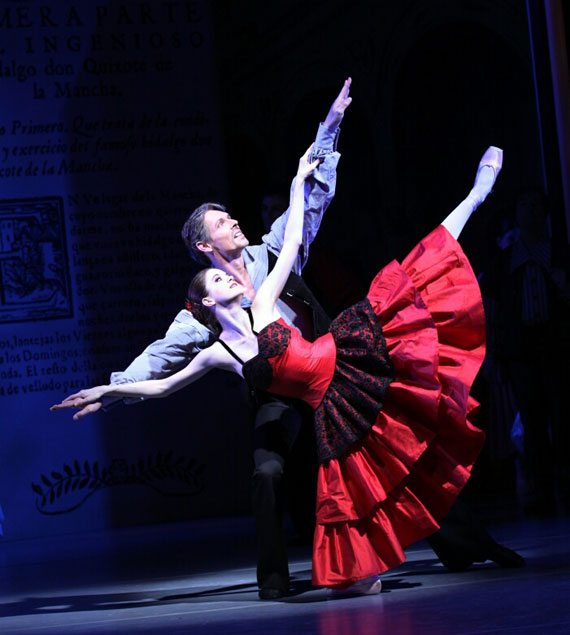
| Kritiken » Vorstellungen » Vorstellungen 2008/2009 » Bunte Träumereien in Lüneburg |
|
Lüneburg, 09.02.2009 Bunte Träumereien in Lüneburg Eine kleine Kompanie tanzt „Don Quixote“ ganz groß Die Abenteuer von Don Quixote waren eigentlich nur als Parodie auf die massenhaft gelesenen Ritterromane seiner Zeit gedacht. Letzten Endes hat Miguel de Cervantes mit seinem Roman ein Stück Weltliteratur geschaffen, das bis heute nichts von seiner Faszination verloren hat. Schnell entdeckte die Ballettbühne den Stoff für sich. Marius Petipa, der Ballettklassiker wie Schwanensee oder Dornröschen choreografierte, schuf eine Version von „Don Quixote“, die mit leichten Abweichungen heute noch von den großen Ballettkompanien getanzt wird. Virtuose Variationen mit waghalsigen Sprüngen, Drehungen und Balancen verlangen den Solisten dabei alles ab. Charakteristisch für dieses Ballett sind auch die bunte Gruppenszenen, die mit spanischen Volkstänzen den Lokalkolorit der Geschichte hervorheben, getragen von der Komposition von Ludwig Minkus. Wie aber kann ein so opulentes Werk von einem kleinen Ensemble wie dem Lüneburger Ballett stilgerecht auf die Bühne gebracht werden? Ist ein solches Vorhaben für eine Kompanie, die gerade mal rund ein Duzend Tänzer umfasst, nicht von vornherein zum Scheitern verurteilt? Keineswegs lautet die Antwort. Mit bunt gestalteten Szenen, einer temporeichen Choreografie, die auch Platz für lyrische Pas de Deux lässt und einer gut durchdachten Dramaturgie bietet der „Don Quixote“ von Ingrid Burmeister beste Ballettunterhaltung. Dabei gelingt es ihr die charakteristischen Elemente aus der bekannten Petipa-Choreografie zu integrieren und geschickt mit eigenem Schrittmaterial zu erweitern. Don Quixote ist ein Träumer und er nimmt den Zuschauer mit in seine Traumwelt. Dabei steht der Ritter von La Mancha gar nicht selbst im Vordergrund der Handlung, sondern hält diese nur zusammen. Wie in den meisten Ballett-Adaptionen geht es um die Liebesgeschichte zwischen der Gastwirtstochter Kitri und dem Barbier Basil. Kitris Vater hat seine Tochter bereits dem reichen Gamache versprochen und erst in letzter Minute, während die Hochzeitszeremonie schon in vollem Gange ist, gelingt es Don Quixote die wahren Liebenden doch noch zu vereinen. Yarica von der Osten als Kitri und Matthew Sly als Basil zeigen in kunstvollen Pas de Deux ein elegantes Zusammenspiel. Ihre Geschichte wird verziert durch viele kleine Geschichten der Dorfbewohnern und dem Kinderballett. Hier entspannen sich kleine Szenen, die herrlich die Komik der literarischen Vorlage umsetzten. Besonders die Figur des reichen Verlobten von Kitri, getanzt von Oleg Trutnev, bringt das alberne Element zum Vorschein. Aber auch ein weiterer Aspekt der Geschichte von Don Quixote wird in dieser Inszenierung intelligent umgesetzt. Es geht um die Auseinandersetzung mit Fiktion und Realität, mit Traum und Wirklichkeit. In der literarischen Vorlage sind es Windmühlen, die Don Quixote bekämpft, fest davon überzeugt es seien Riesen. Überdimensionale Bücher spiegeln im Bühnenbild von Barbara Bloch diese Fiktions-Thematik wieder. So wirken die Figuren im Vordergrund tatsächlich als wären sie den Seiten entsprungen. Und diese bunte Welt des spanischen Dorfes wird wiederum durch Traumsequenzen durchbrochen. Immer wieder gibt sich Don Quixote (Thomas Pfeffer) in lyrischen Pas de Deux Träumen hin, in denen er seiner Geliebten Dulchinea begegnet. Diese nimmt immer wieder unterschiedliche Gestalt an und begegnet ihm am Ende des zweiten Aktes sogar gleich in vierfacher Ausführung. In Brautkleidern und mit verschleierten Gesichtern trippeln die vier Dulcineen über die Bühnen - unverkennbar ein Zitat der Willis aus Giselle. Eine schöne Idee der Umsetzung, spiegelt dieses Ballett doch ideal die romantische Flucht aus der Wirklichkeit in eine Traumwelt wieder. Die ruhigen Pas de Deux von Don Quixote stehen im Kontrast zu den temporeichen Gruppenszenen der spanischen Gesellschaft. Die farbenfrohen Kostüme und die folkloristischen Schrittfolgen sind schön arrangiert. Spätestens im abschließenden Grand Pas de Deux von Kirti und Basil (im klassischen Tutu und Torero-Outfit) treten die Lüneburger den Beweis an, dass sie die schwierigen Balancen, Hebefiguren, Sprünge und Drehungen glanzvoll beherrschen und dass ein großes Ballettwerk auch auf einer kleinen Bühne stilvoll und unterhaltsam umgesetzt werden kann. Großer Applaus vom Lüneburger Publikum. Autor: Lena Zieker |
| © tanznetz.de 1996-2009 |


